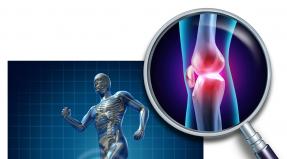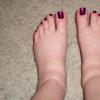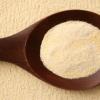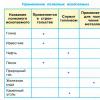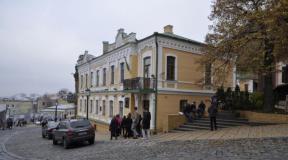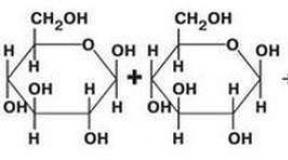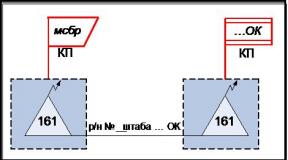Hello, Doctor. I have varicose veins on…. Why does redness of the leg appear after removing the compression stocking? Treatment with compression hosiery
I visited a phlebologist, she ordered me to wear Medi compression hosiery. After the daily removal of compression hosiery of the 2nd degree of compression, there is a cut pain above the knee, I can not sleep! I am not a doctor, but I suspect that after the jersey is removed, the blood begins to circulate through the external vein. Help, what should I do? Sleep in it?
ANSWERED: 12/13/2016
Hello, please give more information on the latest ultrasound duplex vein scan, preferably a photo appearance the affected limb. as well as the duration of the disease. what lingerie do you wear stocking, golf, or tights?
Clarifying questionSimilar questions:
| date | Question | Status |
|---|---|---|
| 25.02.2018 |
The left leg hurts when walking on the back surface. The pain is constant and aching, present only during movement. The pain floats: now it can be under the knee, tomorrow it can be localized in the internal muscles of the thigh (here it is constantly). In the morning I get up in different ways, sometimes I need to warm up. After serious physical exertion, the radius of pain increases, in addition to the leg, the sacrum begins to hurt and a little to the left of it. From time to time it becomes painful to lean on, to sit on the left buttock of the sore leg, but not all the time. At... |
|
| 16.09.2012 |
Hello. A vein protruded on the right leg after pregnancy (5 years ago). A year ago, pains began, the leg under the knee swells, even a small bruise leads to a huge bruise. I went to the clinic to see a surgeon (we do not have a phlebologist), he did an ultrasound scan of the veins and gave a referral to the hospital for an operation to remove a vein, as he discovered reflux osteal valve. At the hospital, a phlebologist suggested that I do a second ultrasound from them (for a fee), after which the operation was refused, although the diagnosis was confirmed ... |
|
| 28.07.2014 |
Hello! As far as I can remember, my legs have always hurt when walking, when I stand for 5 minutes, and if not every day, then every other day my legs flow out, especially my left leg. The veins are not so visible, and if they are, then where the knees bend behind. They checked the kidneys, kidneys are normal, donated blood and blood counts and was on ultrasound. Previously, in my student days, 15 years ago, I could wear high-heeled shoes, but now it's not like heels, even with flat soles, I feel discomfort. There is no phlebologist in our city. Dont know... |
|
| 16.07.2014 |
Hello. I am 13 years old. Several years ago, 2 or 3, I don’t remember specifically, my mother hit her foot hard on the corner of an iron chair because of the pain she almost lost consciousness (hit the lower part of the knee just below somewhere in the middle) and there seemed to be some kind of dent on her leg. Every day. Well, or for a month around this place of the blow of the vein, the vein swells up and becomes some kind of blue, and well, how to explain how. Disheveled pigtail. If you look and compare two legs, this one looks thicker and if you touch it ... |
|
| 02.08.2019 |
Hello, I had an injury a year ago. During the fall, the vessel burst and blood went into the knee joint. Pumped out 3 times, applied splint. The treatment helped. Now I am concerned about knee pains, I was diagnosed with a knee joint, I have been receiving treatment for a month now, but nothing helps. Can you please tell me what can be done? |
Compression hosiery is usually used to improve blood flow to the extremities. In most cases, tights and stockings are made from such knitwear, which are recommended to be worn for problems such as thrombosis, phlebitis and leg swelling.
Compression hosiery stockings and tights
The knitwear from which these stockings are made is specially designed to squeeze the limbs, improving blood circulation in them. As a rule, the tissue exerts the strongest pressure on the lower leg area, and above its density decreases. This stimulates the flow of blood from the legs up to the heart.
Compression hosiery helps relieve pain, discomfort, and swelling caused by varicose veins. However, there is still no unequivocal opinion as to whether such stockings and tights prevent the aggravation of the symptoms of varicose veins and the appearance of new varicose veins. Research is mixed, but this may be due to the fact that many people do not wear compression garments on a regular basis. Therefore, you need to carefully choose the design of such stockings or tights and wear them in accordance with the doctor's recommendations.
In most cases of varicose veins, doctors recommend wearing compression stockings or tights with mild to moderate compression. Strong compression stockings can be recommended for problems such as atrophy, dermatosclerosis, secondary varicose veins  , post-thrombolytic venous insufficiency.
, post-thrombolytic venous insufficiency.
If stockings bought at a pharmacy do not suit you, you can order stockings that will be made according to your individual characteristics.
Typically compression stockings  or claws should be put on in the morning and removed only at bedtime. Tighten the stockings carefully so that they apply the necessary force on each part of the leg.
or claws should be put on in the morning and removed only at bedtime. Tighten the stockings carefully so that they apply the necessary force on each part of the leg.
It can be uncomfortable to wear compression stockings all the time, especially in warm weather, but it is necessary to get the most out of them.
Sometimes products from compression hosiery cause dryness and flaking of the skin; in this case before bedtime  should be applied to the skin with a moisturizer. Talk to your doctor if this does not help and / or very severe flaking and itching occurs
should be applied to the skin with a moisturizer. Talk to your doctor if this does not help and / or very severe flaking and itching occurs  .
.
Compression stockings need to be replaced every three to six months as they gradually stretch and no longer function. Compression knitwear should be washed by hand in warm water and dried at a sufficient distance from heat sources (in no case dry it on a battery - this will very quickly reduce the effectiveness of the knitted fabric).
Phlebeurysm
One of the common diseases of cardio-vascular system is varicose veins. Among the vascular pathology, varicose veins generally rank first in terms of frequency of occurrence. This disease is associated with an increase in the diameter of the superficial veins. lower limbs and a deterioration in the outflow of blood from them.
As you know, the blood pressure in the veins is much lower than in the arteries. This is due to the fact that blood flows through the arteries in the direction from the heart, and through the veins - to the heart. Therefore, it is quite natural that the acceleration given by the heart impulse dies out more and more with distance from the heart. From this it follows that in the veins the inertia from the heart contraction is generally minimal. How is it deoxygenated blood returns from the lower extremities to the heart, especially considering the fact that she has to climb up through the vessels, overcoming the force of gravity?
It turns out that on the inner surface of the venous vessels there are special valves that have a semilunar shape and face upward. When moving down the veins, the blood fills the pockets of these valves, they open and block the entire lumen of the vessel, preventing the return of venous blood. That is why venous blood in the lower extremities (as, indeed, in other parts of the venous bed) cannot flow downward. And what makes it move up to the heart? Firstly, these are the same systolic heartbeats, which, even if not so significant, still play a role in the movement of blood through the bloodstream. Secondly, venous vessels, like arterial ones, have muscle fibers in their walls, which have a certain effect on the movement of blood. And thirdly, the most important factor is the contractions of the skeletal muscles of the lower extremities, which massage the veins and give the blood flow the right direction. This phenomenon is called the muscle pump. That is why, during a long stay in a standing position, after a while we feel a feeling of fullness in the supporting leg, which causes an urgent need to change the position of the body and forces us to change the supporting leg. In the process of "changing" the leg, the stagnant vein is squeezed by the muscles, and the blood is pushed further through the vessels, and we feel a certain relief. In this case, the semilunar valves are not able to completely block the lumen of the vessel, the blood is pushed worse and worse through the veins, the patient begins to experience an unpleasant feeling of fullness in the legs. By the end of the day, the legs become very tired and swollen. The veins themselves become very clearly visible, first in the form of vascular "stars", and then in the form of swollen snakes. Over time, in the area of localization of the affected vessels, the skin begins to suffer, which is manifested by the appearance of ulcers. The reason for their appearance is the deterioration of microcirculation and a violation of the blood supply to the skin, which means that less oxygen and essential nutrients are supplied. That is why such ulcers are called trophic (that is, associated with poor nutrition).
Treatment with compression hosiery
For the treatment and prevention of varicose veins to one of the most affordable, painless and effective methods includes the use of compression hosiery. The material for this is a high-strength fabric (cotton, elastoden), capable of exerting constant uniform pressure on the superficial veins, preventing them from expanding. Stockings and tights made of compression hosiery should be used after surgical interventions in the venous system, during pregnancy, during intensive strength training(especially weightlifters), with long transitions or even moving, as well as people whose profession is associated with a long stay in a standing position (turners, milling machines, salesmen, and so on). For permanent wear, compression hosiery is recommended for patients diagnosed with varicose veins veins to avoid the progression of the disease.
A prerequisite effective action compression hosiery is the observance of the rules of putting on the appropriate underwear. This should be done while still in bed, so that the blood does not have time to overflow and "stretch" the veins. It is also advisable to take off linen in bed. The compression hosiery should be washed daily, but without strong detergents. After washing, it is better to dry the material in the air, but without access to direct sunlight and not on a battery - this can reduce the elastic and compressive properties of the knitted fabric.
Compression hosiery can exert different pressure on superficial veins. The degree of compression depends on the diagnosis, so this issue should be carefully discussed with your doctor.
Zhigula Andrey
By purchasing a product of compression hosiery of the required length and the required compression class, it is necessary to achieve the maximum effect from its therapeutic effect(about what kind of information followspossess before, as discussed in previous articles). And for thisit is important to know how to put it on and wear it correctly.
It is known that by the end of the day, due to the action of the forces of hydrostatic pressure, our legs increase.in volume, and with varicose veins - they become pasty and can even swell significantly. Per nightthere is an outflow of blood from the limbs and the volume of the legs decreases. Therefore, wear preventive orneed in the morning while in bed. In this respect, veryspecial orthopedic pillows may be useful, which give the legs a slightelevated position and, thus, favors venous outflow. Putting on compressionproducts in the morning will help to ensure the necessary physiological distribution during the daypressure necessary to maintain vascular tone, and to avoid the appearance or growth of edema.
The main condition that will help to achieve a positive result when using- this is his constant wearing. This is especially true in cases whereit is recommended by the attending physician. Unfortunately, there is a misconception that if after two or threedays of wearing compression socks, stockings or tights, the legs stop hurting and swelling, then the desiredthe result is achieved. This fairly common misconception can negate all the previous treatment success.
Remember that the constant wearing of compression hosiery for varicose veins is part of the general therapy andthe key to a successful recovery.
Several general recommendations for the care of products included in the group of compression hosiery.Having bought compression hosiery, first of all, pay attention to the attached instructions foruse and recommendations for care. Usually compression sleeves, leggings, stockings, tights and knee-highswashed in warm (never hot) water using detergents that do not containchlorine. It is important to remember this because high temperatures and chemicals can enter intochemical reactions, or catalyze chemical processes that affect elastic andcompression properties of products. For the same reason, it is not recommended to stretch compression garments.or twist. The practice of caring for compression hosiery shows that it is better to dry it instraightened out with room temperature and natural light (i.e. avoid drying in direct sunlight). It should also be remembered that such products should not be dried on a battery, as this negatively affects the condition of the used elastic materials and reduces their compressive qualities..
In the summer you want to look attractive! Wear short dresses and skirts, show off your perfect tan on the beach ... Stop. What if your legs are far from ideal? If you are worried about dilated veins, spider veins, heaviness and pain in swollen legs? Contrary to popular belief, varicose veins are not a cosmetic problem. However, there are methods to restore beauty and health to your legs.
Phlebeurysm
Every tenth inhabitant of the Earth suffers from varicose veins, and most of them are women from 30 to 70 years old. Quite often, the occurrence of this dangerous condition is due to the wearing of high-heeled shoes, hormonal changes during pregnancy and during the period.
I must say that the symptoms of varicose disease that arose during pregnancy and childbirth within 3 months after the birth of a child can disappear on their own without any intervention. And only if the problem persists, it needs to be observed and measures to be taken to eliminate it.
The main cause of varicose veins can be damage or some hereditary defects of the venous valves, as a result of which they are not able to prevent the backflow of blood into the legs: normal blood flow is disturbed, the veins overflow with blood and expand.
Age and heredity also affect the development of the disease: most often the disease develops after 45 years, and the risk is higher in those people whose relatives suffer from varicose veins. The risk group also includes people leading a sedentary lifestyle or, conversely, practicing serious physical exercise and weight lifting, whose work is associated with prolonged stay on the legs, overweight, high blood pressure and chronic diseases liver.
The first signs and symptoms of varicose veins are the appearance of the so-called asterisks and vascular network on the skin of the legs, a feeling of heaviness and swelling of the lower extremities - occasionally or constantly. Often these phenomena are accompanied by pain in the legs.
It is extremely dangerous to run this condition or consider it a purely cosmetic problem. If nothing is done on initial stages, when you notice only a network of blood vessels or "stars", then over time, the reddening of the skin in the area of veins, which are increasingly losing elasticity, will only intensify, pain, tingling and even cramps will bother you.
If you wave your hand at this stage, you can face the fact that the veins will become nodular and protruding, the nutrition of the skin will be disturbed, which leads to the appearance of skin dermatitis, and then venous ulcers. Slowing blood flow in diseased veins, susceptibility to injury and inflammatory changes increase the risk of thrombophlebitis.
Therefore, it is imperative to be treated. During therapy, the following tasks are solved:
- strengthening the walls of the veins;
- increased tone of the venous walls;
- normalization of blood flow;
- anti-inflammatory therapy;
- treatment of local complications arising from varicose veins.
Modern medicine offers several gentle methods of treating varicose veins. These methods can be divided into two types: conservative and surgical.
Conservative methods of treating varicose veins
The best conservative remedy for the treatment and prevention of varicose veins is wearing special compression underwear(stocking, golfs, tights). With the constant use of this jersey, uniform pressure on the legs is provided, which helps to normalize blood circulation and improve its outflow, while weak vascular walls are well supported. Compression garments reduce the load on the veins, slow down the progression of the disease and reduce the risk of thrombosis.
Modern compression hosiery can be therapeutic and prophylactic. At different stages the disease shows a compression of a certain strength. Please note that only a phlebologist will be able to choose the right underwear, taking into account the individual characteristics of a person. V preventive purposes it is useful to wear compression stockings and tights with a sedentary, sedentary lifestyle, during pregnancy, with a hereditary predisposition or with prolonged physical exertion.
As support in complex treatment used by drug therapy, which is able to reduce pain, swelling, reduce the level of discomfort, but completely stop the disease, without the use of other measures, cannot. Usually recommended drugs suppress inflammatory intravascular reactions, reduce the permeability of the venous wall, increase the tone of the veins, and improve blood microcirculation. It is most reasonable to combine the intake of the drug with elastic compression.
Exercises for leg and vein health
Be physically active: practice active walking, take breaks from sedentary work, sign up for a pool or yoga, ride a bike, and do simple exercises to improve circulation in your legs:
- Standing on your feet, alternately lift the heel of your left and right feet off the floor.
- Standing on your feet, lift up on your toes, and then slowly return to the starting position.
- Lying on your back, alternately bend and unbend your legs at the ankle.
- Lying on your back, do the "bicycle" exercise: alternately raise your legs bent at the hip and knee joint(imitating cycling).
- Sitting on a chair, roll a small, hard ball (such as a tennis ball) across the floor with your feet.

To combat the disease, a special physiotherapy, massage, vitamin complexes, ointments and creams. but conservative therapy only slows down the process, not completely eliminating the disease. And then the question arises: what are the currently minimally invasive (that is, sparing) methods of surgical correction of venous disease?
Minimally invasive methods of treating varicose veins are interventions that the surgeon performs through small punctures of the skin, without incisions. Naturally, this treatment is much less traumatic than classical surgery. Surgical interventions are performed on an outpatient basis under local anesthesia, after which the patient can go home, provided that all recommendations are followed.
Let's consider these methods in more detail.
Sclerotherapy
it modern method combining low-traumatic effects with excellent cosmetic results and high efficiency... It is usually applied to early stages and is safe and comfortable for the patient. Since the method can cope not only with spider veins, but also with diseased veins, it is used both as a stand-alone procedure and as an addition to almost any leg surgery.
With sclerotherapy, only varicose veins are selectively removed, while healthy areas veins are preserved. During the procedure, a special solution (sclerosant) is injected into varicose veins or "spider veins" by injections. A sclerotherapy session takes no more than an hour and includes three to ten injections (depending on the purpose of the procedure). In total, from one to five procedures are required, carried out about once a week.
A compression hosiery is put on immediately after the manipulation. During treatment, there is a slight soreness and induration when touched, which disappears within a few weeks. And as a result, the condition of the legs improves significantly: dilated vessels, edema, painful sensations, the correct outflow of blood is restored.
Laser treatment
The essence of laser treatment is intravascular closure of the lumen of diseased veins, but the veins themselves are not removed. During the procedure, a special needle is inserted into the vein, through the hole in which a disposable laser wire is passed. Then, under ultrasound guidance, the wire (light guide) is advanced to the sore spot.
Anesthetic is injected around the vein, and energy is supplied to the light guide, as a result of which the laser beam "glues" the diseased vein, as it were. It turns into a flagellum, which eventually dissolves in the leg. After the operation, blood begins to circulate through other healthy veins. The operation on one leg takes about 15-30 minutes, on two - 40-55 minutes.
Using a laser, you can not only eliminate the affected veins, but also heal trophic ulcers... This is a very effective technique, the result of which is comparable to the "classic" surgical intervention - combined phlebectomy. main feature laser method - its low invasiveness (there is practically no chance of damaging the nerves and lymph ducts, no incisions are made) and an excellent cosmetic result - healthy legs without traces of interference.
Miniflebectomy
It is also a minimally invasive, highly effective procedure that is most often performed under local anesthesia on an outpatient basis. During the operation, diseased veins are removed through small punctures of the skin and pathological veno-venous discharges are eliminated (the main reason for the development of varicose veins). No sutures are applied, the edges of the wounds are simply pulled together with a special plaster (steril-strips).
You can walk within an hour after the operation, but bruises persist for up to 10-14 days. Almost invisible scars remain at the puncture site, but they also dissolve over time. Usually, pain after miniflebectomy are poorly expressed or none at all.
After the manipulation, you need to wear compression underwear for about a month and be monitored by a phlebologist. V postoperative period it is recommended to maintain an active lifestyle, walk, ride a bike. After a few days, the patient can already return to work and normal life.
Miniflebectomy can be performed independently or as part of a combination treatment for varicose veins. It is combined with laser vein treatment and sclerotherapy. The method of application is determined individually, the results of duplex ultrasound scanning of the venous system must be taken into account.
Comment on the article "3 ways to get rid of spider veins on foot"
More on the topic "Treatment of varicose veins":
Why varicose veins are predominantly female disease? Varicose veins - how to prevent and what to do. Treatment of varicose veins.
I got to the phlebologist. Legs did not bother, did not swell, did not hurt ... from summer / autumn I began to notice a vein on my right leg - that is, no ... I reached the doctor. Duplex ultrasound scanning of the veins of the lower extremities - says it is necessary to operate. Take my opinion and go for a consultation with a professor who will tell you everything about hospitalization and surgery ... So right away?
Not very pronounced yet. And my mother's, but my grandmother's - it's generally scary to look there, they have already operated on - they removed a vein. In general, heredity, damn it. I'm afraid the same will happen to me. Do I have a chance and what needs to be done, what will be the tips ?. Any opinion interests, but it is especially interesting to listen to those who really coped with the problem.
Treatment of varicose veins. Section: Hospitals, clinics (free surgery to remove varicose veins in Moscow for a resident of varicose veins - treatment, advice from a phlebologist.
Girls, tell me where in Moscow / Moscow region is it better to do such an operation ?? May be preliminarily examined ... I find out for the mother of a close friend - she is already over 50, and she has already done similar operations twice, once operated on, the second - they burned something there with a laser. And here again ...: ((
Still, the better (safer or more harmless :) to remove the mesh from the body? I read both about the laser and about the foam solution, but I could not find a clear comparison of these methods .. Maybe someone has come across such information?
I have severe varicose veins, my leg is straight blue, I didn’t manage to sunbathe in the summer, and from this year I’m allergic to the sun :) What means to smear to get a light bronze tint? And has anyone used self-tanning products at Yves Rocher's?
Treatment of varicose veins. Diseases. Medicine and health. Diseases, symptoms and their treatment: tests, diagnosis, doctor, medications, health.
My husband has very strong hereditary varicose veins. Does anyone know a good clinic, a specialist in these matters, so that not just a wiring for money, but a good sense ... It is very necessary! Thanks in advance:)
Girls, can someone tell me here ... We played paintball, and my own husband shot me from one meter :)) - a terrible bruise with a diameter of 6-7 cm on the thigh, and we will go to Turkey the day after tomorrow. I already smeared it with a lifeguard and mazyukalas with troxevasin, so far there are no special effects :(.
How to get rid of spider veins on your legs? During my pregnancy, spider veins began to appear on my legs. And after giving birth, I was looking for ways to get rid of them. Those with the same problem will understand me. Therefore, accidentally seeing in ...
Untie the varicose knot. Varicose veins: prevention and treatment. The first symptoms of varicose veins. Diagnosis of varicose veins. If the disease is still only at the initial stage ...
3 ways to get rid of spider veins on your legs. You can walk within an hour after the operation, but bruises persist for up to 10-14 days. The doctor claimed that he was one of the rare specialists in Moscow who, instead of having vein surgery, performed sclerotherapy.
The disease is common. Maybe someone was involved in the treatment? Share information. Interested in everything
Tell me where it is better to remove the spider veins on the face of a girl (5 years old). And what is the least painful method? I was going to do an operation at 1 Gradskaya to remove varicose veins on my legs. 3 ways to get rid of spider veins on your legs.
How to get rid of spider veins on your legs? Sprockets on the legs: removal and treatment. Today, there are invasive and conservative methods for removing varicose asterisks. Foot Balm Dr. Foot Marketing ploy or the truth about the miracle cream?


